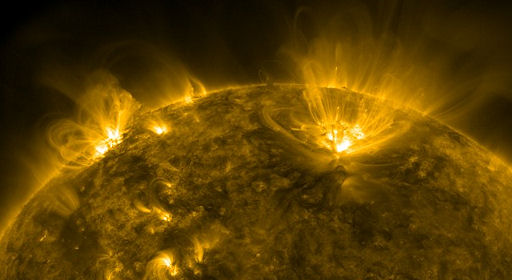ASTEROID FLYBY: Newly-discovered asteroid 2012 TC4 will fly past Earth on Oct. 12th only 96,000 km (0.25 LD) away. There is no danger of a collision, but the 16 meter-wide space rock will be close enough to photograph through backyard telescopes as it brightens to approximately 14th magnitude. NASA hopes to ping this this object with radar, refining its orbit and possibly measuring its shape. Stay tuned for updates. [3D Orbit] [ephemeris] [more]
ADVANCING SUNSPOTS: For the past two weeks, solar activity has been relatively low. Now, a change is in the offing. The farside of the sun is peppered with sunspots, and some of them are beginning to turn toward Earth. NASA's Solar Dynamics Observatory photographed this pair of active regions advancing over the eastern limb during the early hours of Oct. 11th:
Underlying each nest of glowing magnetic loops is a dark sunspot that poses a threat for solar flares. NOAA forecasters estimate a 40% chance of M-class solar flares and a 5% chance of X-flares during the next 24 hours. Aurora alerts: text, voice.
Realtime Space Weather Photo Gallery
SATISFACTORY LIGHTS: A coronal mass ejection hit Earth's magnetic field on Oct. 8th, sparking a dramatic display of Arctic lights that is only now subsiding three days later. Hugo Løhre photographed the auroras over Lekangsund, Norway, on Oct. 10th:
"I was testing my new Nikon digital camera when these auroras appeared," says Løhre. "I am satisfied."
More lights like these could appear on Oct. 14-15. That's when a stream of solar wind spewing from a hole in the suns atmosphere (a "coronal hole") is expected to reach Earth, possibly sparking geomagnetic storms when it arrives. Aurora alerts: text, voice.

![]()
Solar wind
speed: 447.4 km/sec
density: 0.0 protons/cm3
explanation | more data
Updated: Today at 1515 UT
![]()
X-ray Solar Flares
6-hr max: C1 0811 UT Oct11
24-hr: C4 0804 UT Oct11
explanation | more data
Updated: Today at: 1459 UT
![]()
![]()
![]()
Daily Sun: 11 Oct 12
![]()
![]()
A farside sunspot crackling with M-flares is about to emerge at the circled location. Credit: SDO/HMI
![]()
![]()
![]()
Sunspot number: 71
What is the sunspot number?
Updated 10 Oct 2012
Spotless Days
Current Stretch: 0 days
2012 total: 0 days (0%)
2011 total: 2 days (<1%)
2010 total: 51 days (14%)
2009 total: 260 days (71%)
Since 2004: 821 days
Typical Solar Min: 486 days
Update 10 Oct 2012
The Radio Sun
10.7 cm flux: 106sfu
explanation | more data
Updated 10 Oct 2012
![]()
![]()
![]()
Current Auroral Oval:
![]()
Switch to: Europe, USA, New Zealand, Antarctica
Credit: NOAA/POES
![]()
![]()
![]()
Planetary K-index
Now: Kp= 2 quiet
24-hr max: Kp= 3 quiet
explanation | more data
![]()
Interplanetary Mag. Field
Btotal: 5.1 nT
Bz: 3.0 nT north
explanation | more data
Updated: Today at 1516 UT
![]()
![]()
![]()
Coronal Holes: 09 Oct 12
![]()
![]()
Earth is entering a stream of solar wind flowing from the indicated coronal hole. Credit: SDO/AIA.






